Today’s Current Affairs: 23rd August 2025 for UPSC IAS exams, State PSC exams, SSC CGL, State SSC, RRB, Railways, Banking Exam & IBPS, etc
Table of Contents
Mithi River:
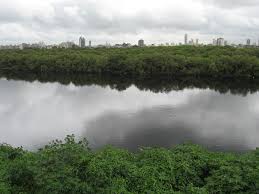
The Economic Offences Wing (EOW) of the Mumbai Police recently arrested a 49-year-old contractor in connection with the multi-crore Mithi river desilting fraud that has caused losses of over ₹65 crore to the Brihanmumbai Municipal Corporation (BMC).
- Mithi river is one of the four rivers flowing through the Mumbai city, Maharashtra.
- The river originates from the overflow of Vihar Lake and also receives the overflows from the Powai Lake about 2 km downstream.
- It flows for 18 km before discharging into the Arabian Sea at Mahim Creek, flowing through residential and industrial complexes of Powai, Saki Naka, Kurla, Kalina, Vakola, Bandra Kurla Complex, Dharavi and Mahim.
- The river has an average width of 5 metres in the upper reaches, has been widened to 25 m in the middle reaches and up to 70 m in the lower reaches after the 26 July 2005 deluge (944 mm in 24 h on 26 July 2005)
- It is a seasonal river, which feeds on the monsoons.
Blue Carbon:
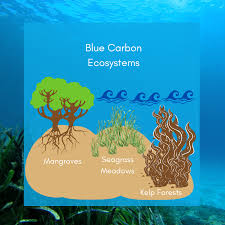
Seaweed farming has emerged as a potential Blue Carbon strategy, yet empirical estimates of carbon burial from such farms remain lacking in the literature.
- Blue Carbon refers to organic carbon captured and stored by the ocean in vegetated coastal ecosystems such as mangrove forests, saltmarshes, or seagrass meadows.
- “Blue” refers to the watery nature of this storage.
- The vast majority of blue carbon is carbon dioxide that has dissolved directly into the ocean.
- Much smaller amounts are stored in underwater sediments, coastal vegetation, and soils; carbon-containing molecules, such as DNA and proteins; and ocean life from whales to phytoplankton.
- These ecosystems store massive amounts of carbon, making them an integral part of global efforts to combat climate change.
- They cover just 2% of the total ocean surface but account for 50% of the ocean’s carbon absorption.
Jeju Island:
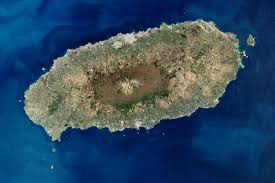
Following complaints from locals about misbehaviour by foreign visitors, police in South Korea’s Jeju Island have printed a special type of multilingual notice.
- Jejudo (also known as Jeju Island) is a volcanic island.
- With a surface area of 1,846 sq.km., it is the largest island 130 km off the coast of the Korean Peninsula and the main island of Jeju Province of South Korea.
- It lies in the East China Sea 60 miles (100 km) southwest of South Jeolla province, of which it once was a part. The provincial capital is the city of Jeju.
- Oval in shape, Jeju Island measures 40 miles (64 km) from east to west and 16 miles (26 km) from north to south.
- The island contains the natural World Heritage Site Jeju Volcanic Island and Lava Tubes.
- A central feature of Jeju is Hallasan, the tallest mountain in South Korea and a dormant volcano, which rises 1,950 m above sea level. 360 satellite volcanoes are around the main volcano.
Huntington’s Disease:
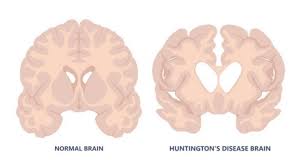
The Union and State governments have yet to include Huntington’s disease in the rare category under the National Policy for Rare Diseases, a demand raised by patients and caregivers in 2024.
- Huntington’s Disease is a genetic condition that affects the cells in your brain.
- It is an inherited condition that causes brain cells to slowly lose function and die.
- If one of your parents has HD, you have a 50% chance of also developing it.
- It affects the cells in parts of your brain that regulate voluntary movement and memory.
- Huntington’s disease affects an estimated 3 to 7 out of every 100,000 people, most often people of European ancestry (biological family comes from European descent).
- Common symptoms include uncontrollable dance-like movements (chorea) and abnormal body postures, as well as problems with behavior, emotion, thinking, and personality.
- Other symptoms may include tremor (unintentional back-and-forth movement in the person’s muscles) and unusual eye movements. The eye movements can happen early in the disease.
- These symptoms get worse over time.
- As HD progresses, you will need constant assistance and supervision because of the debilitating nature of the disease.
- People usually die from the disease within 15 to 20 years of developing symptoms.
- There is no treatment that can stop or reverse HD, but health care providers can offer medications to help with certain symptoms.
Indian Council of Social Science Research:
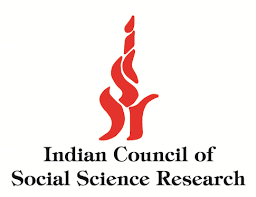
The Indian Council of Social Science Research (ICSSR) recently issued a show cause notice to the Centre for the Study of Developing Societies (CSDS), asking it to disclose the source of funding for its studies on the Election Commission’s Special Intensive Revision (SIR) exercise and the Maharashtra Assembly polls.
- It is the apex body of the Government of India for research in the social and human sciences.
- It was established in the year 1969 by the Government of India on the recommendation of Prof. V. K. R. V. Rao Committee.
- It is an autonomous organisation working under the aegis of the Department of Higher Education, Ministry of Education.
- ICSSR plays a pivotal role in advancing knowledge and understanding of various social issues and challenges, and providing research-based solutions to policymakers and stakeholders in the development of the nation through initiatives and schemes.
- An all-India network of 24 frontline research institutes and six regional centres is maintained, and five recognized institutes are programmatically supported by the ICSSR.
- The Documentation center of ICSSR – National Social Science Documentation Centre (NASSDOC)-provides library and information support services to researchers in social sciences.
- ICSSR has developed the ICSSR Data Service to serve as a national data service for promoting a powerful research environment through sharing and reuse of data among the social science community in India.
Euglena : New Study
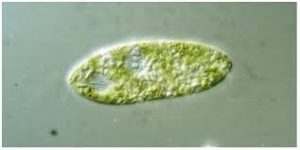
In India, Euglena and its relatives are now widespread indicators of deteriorating water quality.
- Euglena is a unicellular, flagellated microorganism belonging to the group Euglenophyta.
- These are commonly found in stagnant or slow-moving freshwater ponds, ditches, and urban lakes.
- These protists are highly adaptable, capable of both photosynthesis (like plants) and feeding on organic matter (like animals).
- This flexibility helps them thrive in nutrient-rich, oxygen-poor environments.
- Three of the most common euglenoid genera observed in Indian water bodies are: Euglena, Phacus, Trachelomonas sp. These species often dominate surface waters, especially during warmer months.
- The striking red or pink colour seen during blooms is due to a pigment called astaxanthin, produced by many euglenoids.
- Astaxanthin is a fat-soluble xanthophyll that gives these organisms their bright red colour.
- Impact of Euglena on Biodiversity:
- Oxygen depletion: Euglena photosynthesises, but at night it consumes oxygen, leading to diurnal oxygen fluctuations. This can result in hypoxia (low oxygen levels), which is dangerous for fish and other aquatic life.
- Dense surface scums: Euglenoid blooms form thick mats on the water surface, which block sunlight from reaching submerged plants. This reduces the lake’s productivity and alters its ecological balance.
- Fish mortality: Euglenophyte blooms can stick to fish gills, making it hard for them to breathe. Some species also produce toxins like euglenophycin, which directly kill fish or indirectly affect them by disrupting the food chain and oxygen levels.
Dal Lake : Hosted The First-Ever Races
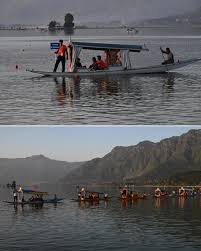
The iconic Dal Lake in Srinagar hosted the first-ever races under rowing, kayaking, and canoeing categories under the Khelo India Water Sports Festival.
- Dal Lake is a mid-altitude urban lake located in Srinagar, Jammu and Kashmir.
- It is surrounded by the Pir Panjal mountains.
- It is integral to tourism and recreation in Kashmir and is named the “Jewel in the crown of Kashmir” or “Srinagar’s Jewel”.
- It is one of the world’s largest natural lakes and also known as the Lake of Flowers.
- The shoreline of the lake is encompassed by a boulevard lined with Mughal-era gardens, parks, houseboats, and hotels.
- The wetland is divided by causeways into four basins; Gagribal, Lokut Dal, Bod Dal, and Nagin (although Nagin is also considered an independent lake).
- Lokut-dal and Bod-dal each have an island in the centre, known as Rup Lank (or Char Chinari) and Sona Lank,
- Dal Lake is also popular for the floating market where vendors have their own Shikaras/wooden boats and approach tourists.
Khelo India Water Sports Festival:
- It is organised jointly by the Sports Authority of India (SAI) and the J&K Sports Council under the government’s ‘Khelo Bharat’ policy.
- It is aimed at boosting grassroots sports, generating livelihoods, and rejuvenating local infrastructure.
- It is the first consolidated Open-age category championships where all 14 kayaking and canoeing events and the 10 rowing events are Olympic events.
Charge-Coupled Device:
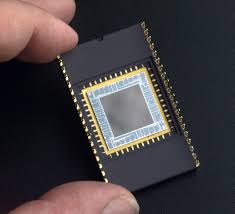
A charge-coupled device (CCD) is a remarkable electronic component whose invention marked a significant milestone in technology and influenced many fields.
- It was a pioneering technology that converted light into electrical signals using an array of capacitors that transferred electric charges in a sequence.
- A CCD consists of an integrated circuit made up of an array of small picture elements called pixels.
- Each pixel acts like a small light sensor that collects photons (the particles of light) and converts them into electrical charges.
- These charges are then transferred across the device, one pixel at a time, to be read and processed into a digital image.
- It operates using the photoelectric effect, where light that falls on the device generates electron-hole pairs in the semiconductor material.
- Specifically, when photons enter a CCD, they strike the semiconductor material beneath each pixel.
- This energy knocks electrons loose, creating a small group of electrons proportional to the intensity of light in that pixel.
- Each pixel is essentially a small capacitor that holds these electrons. The amount of charge in each pixel varies depending on how much light the pixel has received.
- A voltage is applied to electrodes placed over the pixels in a sequence that moves the charges from one pixel to the next, like passing buckets of water along a line.
- This is why it’s called a “charge-coupled” device, and this process continues until all the charge has reached a readout register.
- The accumulated charge from each pixel is then converted into a voltage signal, which can be amplified and digitised by connected electronics to form a digital image.
- This sequential transfer and reading process allows the CCD to create a precise and high-quality representation of a scene being captured.
Exercise Samanvay Shakti 2025:
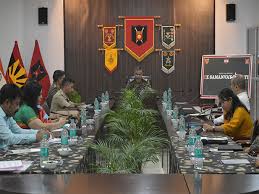
The Exercise Samanvay Shakti 2025 was inaugurated at Laipuli, in Tinsukia district of Assam.
- Exercise Samanvay Shakti is initiated by Indian Army collaboration with state officials of Assam & Manipur to foster efficient cooperation, cohesion and mutual understanding.
- It is a military-civil Integration exercise aimed at fostering synergy between security forces, government departments and civil institutions to address the region’s complex challenges through a unified and coordinated approach.
- The inaugural session witnessed participation from the Indian Army, Indian Air Force, District Administration, Police, Intelligence Agencies, NDRF, SDRF, Medical Officials, BRO & GREF, Railways, educational institutions and security officials from OIL India, IOCL and Coal India alongwith representatives of the local media.
- Objectives of Exercise Samanvay Shakti is To take concrete steps towards achieving an improved state of readiness, supported by unhindered channels of communication and refined standard operating procedures through practical rehearsals.
- It seeks to further strengthen the bond of trust between the people of upper Assam & Manipur and the institutions that serve them, thereby contributing towards preparedness for security challenges, development towards nation building, and reinforcing national integration.
Key Highlights of the CAG Review:
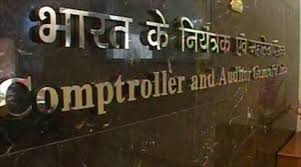
The Comptroller and Auditor General (CAG) presented its 2023-24 annual review of the Fiscal Responsibility and Budget Management (FRBM) Act, 2003, in Parliament.
- The review shows that India is moving steadily towards long-term macroeconomic stability.
- Key Highlights of the CAG Review of the FRBM Act for FY 2023-24:
- Central Government Debt: Declined to 57% of Gross Domestic Product (GDP) (March 2024) from 61.38% in FY 2020-21.
- General Government Debt (GGD): GGD declined slightly from 83% of GDP in March 2022 to 81.3% in March 2023, still far above the 60% target.
- Debt Sustainability Analysis (DSA): DSA assesses the government’s ability to service debt, with the debt-to-GDP ratio as the key measure.
- A sustainable fiscal policy is one where the debt-to-GDP ratio is stable or declining over the long term.
- The Centre’s debt-to-GDP ratio peaked at 61.38% in FY 2020-21 and declined to 57% in FY 2023-24.
- Unrealised Taxes: At the end of FY 2023-24, Rs 31.11 lakh crore in taxes remained unrealised, up Rs 9.81 lakh crore from the 2022-23.
Reserve Bank of India (RBI) released its discussion paper (August 2025) on reviewing the flexible inflation targeting (FIT) framework:
The Reserve Bank of India (RBI) released its discussion paper (August 2025) on reviewing the flexible inflation targeting (FIT) framework. With the current 4% CPI target within a 2–6% tolerance band expiring in March 2026, the RBI has cautioned that raising the target could dilute credibility and reverse policy gains.
Rationale for Retaining the 4% Target
- Credibility with Global Investors: Raising the target could be read as tolerance for higher inflation, weakening policy reputation.
- The recent S&P Global upgrade to BBB highlighted RBI’s inflation management as a pillar of investor confidence.
- Institutional Stability: The framework has built confidence in the MPC process and fiscal responsibility norms.
- Domestic Outcomes: Headline CPI inflation has largely stayed within the 2–6% band since 2016, reflecting policy success.
- The July 2025 figure of 1.55%, the second-lowest since the series began, is evidence of stability.
- External Balance: Low and stable inflation protects the rupee, maintains external competitiveness, and prevents erosion of capital inflows.
Kerala Declared India’s First Fully Digitally Literate State:
Kerala Chief Minister declared Kerala as the first fully digitally literate State in India, marking the completion of Phase I of the Digi Kerala project. The initiative sought to bridge the digital divide by training individuals in basic digital skills across all local bodies.Surveys covered 1.5 crore individuals from 83.46 lakh families. Identified 21.88 lakh digitally illiterate persons, of which 21.87 lakh (99.98%) successfully completed training and evaluation. Even senior citizens, including 104-year-old M.A. Abdullah Moulavi Baqavi, participated—showcasing accessibility and inclusiveness. Training delivered through local bodies, reflecting Kerala’s strong decentralisation and participatory governance tradition.
Fortified Rice Scheme Extended till 2028:
The Union Cabinet has approved the continuation of universal supply of fortified rice under all government schemes till December 2028 with 100% central funding of ₹17,082 crore. A nutrition intervention programme to supply rice fortified with Iron, Folic Acid, and Vitamin B12 through government food safety nets. Aims to combat anaemia, malnutrition, and hidden hunger in India. Started in Pilot phase launched in 2019. National scale-up approved in 2022 for universal coverage. Nodal Ministry & Agency :Department of Food and Public Distribution (DFPD) under the Ministry of Consumer Affairs, Food and Public Distribution.Technical standards framed by FSSAI (Food Safety and Standards Authority of India).
SEBI Moots ‘Regulated Venue’ for Pre-Listing Companies:
The Securities and Exchange Board of India (SEBI) has proposed creating a “regulated venue” for trading shares of pre-listing companies.A formalised platform under SEBI oversight where unlisted companies’ shares can be traded before their Initial Public Offering (IPO). Will function as a transparent alternative to the unregulated grey market. Grey Market is an informal market where shares of companies that are about to be listed trade between buyers and sellers based on mutual agreement. Operates outside regulatory purview, lacking transparency and investor protection.
Penalty of ₹10 lakh on Rapido:
The Central Consumer Protection Authority (CCPA) has imposed a penalty of ₹10 lakh on Rapido for misleading advertisements promising “Auto in 5 min or get ₹50”. It also directed Rapido to compensate affected consumers and discontinue deceptive claims. A statutory regulatory body established under the Consumer Protection Act, 2019. Functions as the apex authority for safeguarding consumer rights and curbing unfair trade practices. Established in Formed in July 2020, under Section 10 of the Consumer Protection Act, 2019. Headed by the Chief Commissioner, assisted by two Commissioners (one for goods, one for services).
NTCA Limits Definition of Tiger Corridors:
The National Tiger Conservation Authority (NTCA) has restricted the definition of tiger corridors to only 32 “least cost pathways” (2014 report) and those in Tiger Conservation Plans, excluding newer scientific studies. It is A statutory body under the Ministry of Environment, Forest and Climate Change (MoEFCC). Apex authority for tiger conservation and management of tiger reserves in India. Established in Created in 2005 under the Wildlife (Protection) Act, 1972 through its 2006 amendment.Headed by the Union Minister of Environment, Forest and Climate Change.
RBI Appoints Indranil Bhattacharyya as New MPC Member Ahead of October Policy Meet:
The Reserve Bank of India (RBI) has appointed Indranil Bhattacharyya, Executive Director of the Monetary Policy Department, as the newest ex officio member of the Monetary Policy Committee (MPC). This move comes ahead of the committee’s upcoming meeting scheduled between September 29 and October 1, 2025. Bhattacharyya replaces Rajiv Ranjan, who is retiring, ensuring a seamless transition in the RBI’s key policy-making body.




